INTRODUCTION
Aging society has been considered as one of the most important problems in Japan. Japanese total annual expenditure on national healthcare in fiscal 2013 exceeded 40 trillion yen ($333 billion) for the first time, reflecting the growing number of elderly people.1 Doing regular moderate activities both exercise and sports has lot of benefits for health and would improve the physical fitness and quality of life (QOL). This would also reduce the cost of healthcare. Now-adays, in Japan, most popular exercise for the elderly people is walking. According to the report of Japan’s Ministry of Health, Labour and Welfare, 50.8% people include walking as exercise for their daily health and general fitness.1 The percentage found in 2013 was 2 times more than that in 1994.1 Although, health awareness has been increasing in Japanese people, in general, it is well known that it would be impossible to improve the strength fitness with merely walking. It is reported that the risk of falling down in walking has highest odds rate compared with other exercises. Given this background, the Nordic walking is increasing in Japan, because it is comparatively safe and has higher exercise intensity than walking. In fact, a lot of studies of many medical and health journals in Japan have reported that Nordic Walking is good for health.2 Aging is becoming an important concern all over the world, and hence, we should reinforce strength, flexibility, and coordination abilities.
But the intensity of Nordic Walking might not be enough to improve respiratory muscles. Some new sports that are simplified and enjoyable for everyone should be proposed for all the people of the society irrespective of their age. Recently, there are a lot of studies that confirm that trunk muscle strength or trunk muscle stabilization training have effect on fall prevention in senior citizens.3,4,5 Additionally, deep abdominal muscle strengthening, such as transverse abdominal muscle, contribute to respiratory function and lumbar stability.6 Keeping and enhancing the trunk muscle strength would provide healthy life for senior people. Therefore, Blow Rifle was invented (http://www.blowrifle.com/html/index.php) in Japan keeping in concern the health of senior citizens. Blow Rifle is similar to blowgun, except the dart which isn’t used during shooting. Blow Rifle uses the special ball (Blow ball) that is designed to spin around its axis of symmetry like a rifle bullet (Figure 1). The ball is loaded in the pipe (Blowpipe), which is 600 or 1200 mm in length, the players blow it towards the target via abdominal respiration as strongly as possible. The players exhale the air from their lungs while blowing out the ball. Blow Rifle could become a good sport which will be fun for everyone. From the young to the elderly, a lot of people in Japan have begun to play and enjoy this sport (Figure 2). Therefore, we present this case report about Blow Rifle with their effects on Electromyography (EMG) of the forced expiratory muscles during performing the Blow Rifle.
Figure 1. The Equipment to Enjoy Blow Rifle.
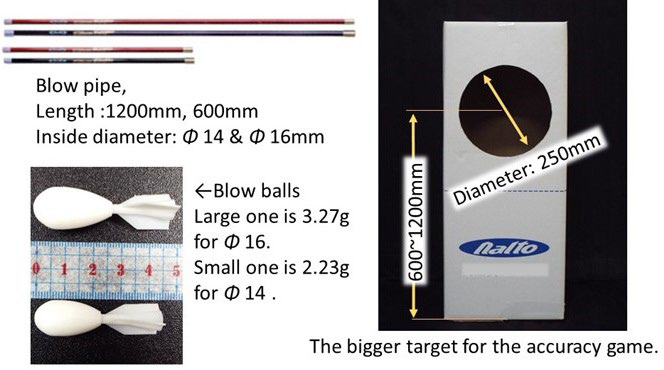
Figure 2. Blow Rifle. Left picture is Accuracy and right is Distance.
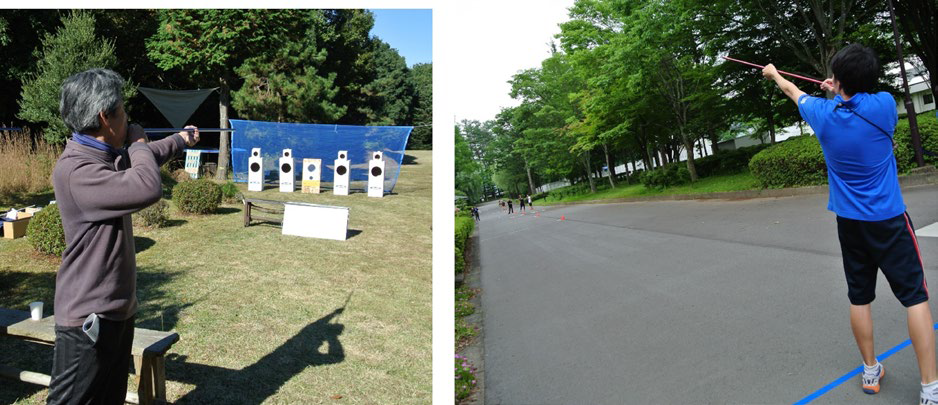
METHODS
Subjects: Five-healthy-males participated in this study (age=21.4±0.9 yr, weight=66.8±6.0 kg, height=171.0±6.6 cm). They regularly undertook exercises, such as basketball, soccer or volleyball, three times per week. They were also familiar with the experimental procedures and the activity of Blow Rifle. Before participation, all participants provided written informed consent. This study was approved by Human Ethics Review Committee of Shizuoka University, Shizuoka, Japan.
Experimental Design
Participants arrived at the laboratory at least 30 min before the experiment where surface EMG electrodes were attached to the experimental muscles and warmed up for the blowing exercise. The electrodes section attached are shown in Figure 3. Then each participant blew the blow balls by using the blow pipe mounted with a strain gauge on the muzzle side of pipe and spirometer (Chestgraph HI101, Chest, Japan) with a thermistor on mouth piece side (Figure 4). Following a warmup, participants completed 2-3 maximal effort trials, while the blowpipe was kept in the horizontal position.
Data Collection
EMG data of greater pectoral muscle (PM), rectus abdominal (RA), Transverse abdominal (TrA), and multifidus muscle of L5 (MF) were collected during blowing (Figure 3). The EMG electrodes were placed over the inferior regions for TrA7 and 2 cm lateral to the spinous process for multifidus muscles.8 Surface EMG activities of the other accessory respiratory muscles, PM and RA, were recorded from the belly of each muscle with preamplifier mounted electrode (EMG Isolator SX230; Biometrics, UK). The skin on each belly was wiped with ethanol, followed by clean cream (Skin Pure; Nihonkoden, Japan), to lower the resistance of the skin between electrodes<10 kΩ. A strain gauge and thermistor were attached on the each end of the blowing pipe to calculate the physical parameters, the time of peak flow and launched blow ball from the pipe after blowing the ball. The analog signals of the EMG, strain gauge and thermistor were simultaneously sampled with an A/D converter (Power Lab 16/35, AD Instruments, New Zealand) at 1 kHz and were stored on a PC. Collected data were analyzed with AD Instruments’ Lab Chart Pro software. The activity of each muscle was showed as a %MVC. %MVC during blowing was averaged for 0.3 sec from blowing.
Figure 3. The Attached Surface EMG Sensor on each Accessory Respiratory Muscle. the data was Synchronized and Collected with Thermistor and Strain Gage Data which Attached on the Edge of Blowing Pipe in 1 kHz Frequency Sampling

Figure 4. A Picture of Experiment. Each Subject used this Pipe to Blow the Ball. This Pipe was Mounted Strain Gauge Plate on the Muzzle side of Pipe and Spirometer Mouthpiece on the Mouth Side.
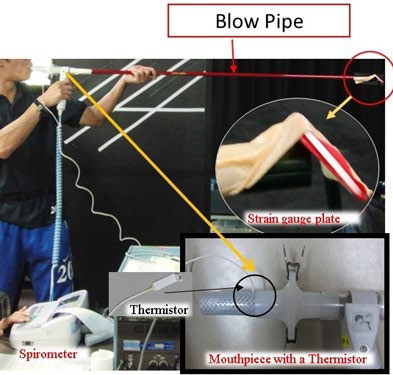
RESULTS AND DISCUSSION
By inhaling deep fresh air and exhaling instantaneously and strongly by blowing, we have discussed about the results of EMG patterns on blowing of Blow Rifle games. The subjects blew the blow balls loaded in the pipe mounted with a thermistor and disposable mouthpiece of the spirometer. Addition to, the plate of strain gauge was mounted on the muzzle of blow pipe.
The activity of each accessory respiratory muscle during blow is shown in Figure 5. The electronic activity of each muscle is amplified between a beginning and after 0.3 sec of blow. PM, RA, TrA and MF increased immediately after the beginning of blow, comparing the EMG pattern of normal expiration during standing rest. This phenomenon was observed in all subjects. Especially, %MVC of TrA is 28.3±15.3 (Table 1). It is illustrated that blowing the blow ball would make more active deep small muscles. Trunk muscle strength is important for balance, functional performance, and fall prevention in seniors.3 TrA and MF are one of them, and their important roles are also reported by the previous study.6,9,10 Kim and Lee6 reported that both FVC and FEV1 significantly increase after transverse muscle strengthening training, comparing with control group. It is suggested that enjoying Blow Rifle would be effective on trunk muscles.
| Table 1. Averaged %MVC of each Muscle During Blowing the Blowball. |
|
PM
|
RA |
TrA |
MF |
| Mean |
6.6 |
3.1 |
28.3 |
3.9
|
|
SD
|
3.4 |
1.2 |
15.3 |
1.2
|
Figure 5. EMG of Accessory Respiratory Muscles during Blowing the Ball (Left). all Subjects have Similar EMG Pattern, Expiratory Flow Carve and the Wave of Strain Gauge Mounted the Top of Pipe. Right Pattern shows EMG for Normal Breathing During Standing Rest.
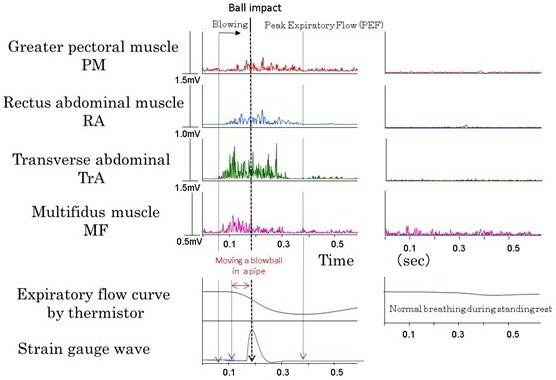
However, there were few limitations of this study as: firstly, the subjects were young healthy males, not senior citizens; secondly, the number of subjects of this study were too less to provide the results through statistical analysis. These residual problems would be resolved in future studies.
Lastly, improving respiratory and trunk muscles will be expected to postural correction or prevent deteriorated posture or falling. International Blow Rifle Association has introduced three competitive games, Accuracy, Distance and Combined (Figure 6). When combined, it is performed with walking, running or other sports, such as Biathlon of winter sports. The combination of these sports would provide various good effects on health and hence enhance QOL. Considering that the respiration is an important fundamental function for our long life, this new sports would be one of the most useful sports which will support the health of aging society. Including Blow Rifle activities with the walking among senior people would improve respiratory muscle strength and trunk strength which may help in prevent falls for which further research in the elderly population is necessary.
Figure 6. Combined Blow Rifle game. The Example of Combined Game, Noridic Walking and Brow Rifle. The Participants Walk a given Distance with Nordic Walking and Blow the 5 Blowballs by 2 or 3 Blowing Rounds. Depending on the Blowing Performance, Extra Distance or Time is Added to the Participant’s Total Running Distance/Time.
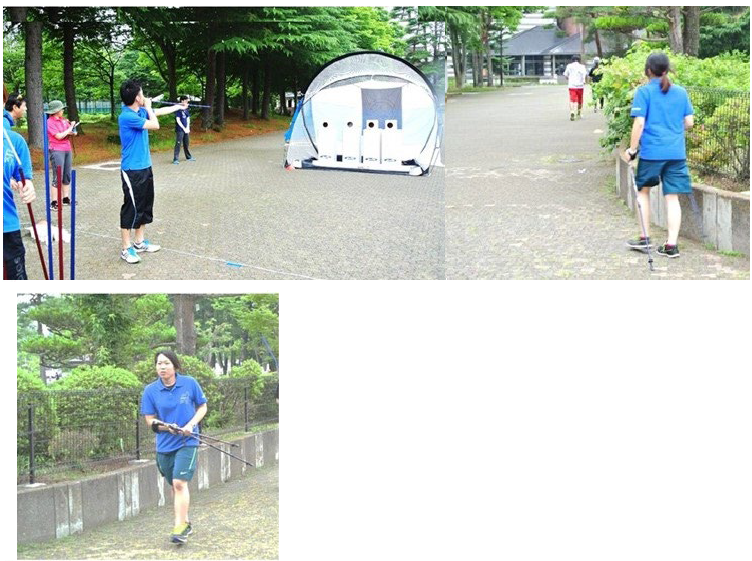
CONSENT
Consent has been taken from the patient’s for purpose of using patient’s photographs for publication in print or on the internet.











